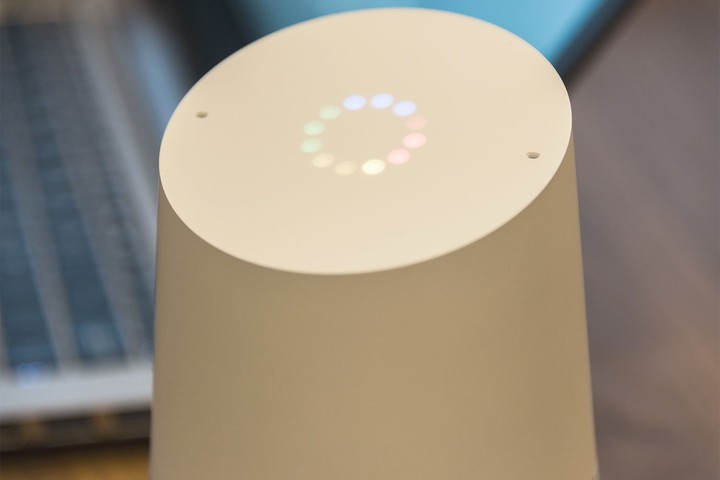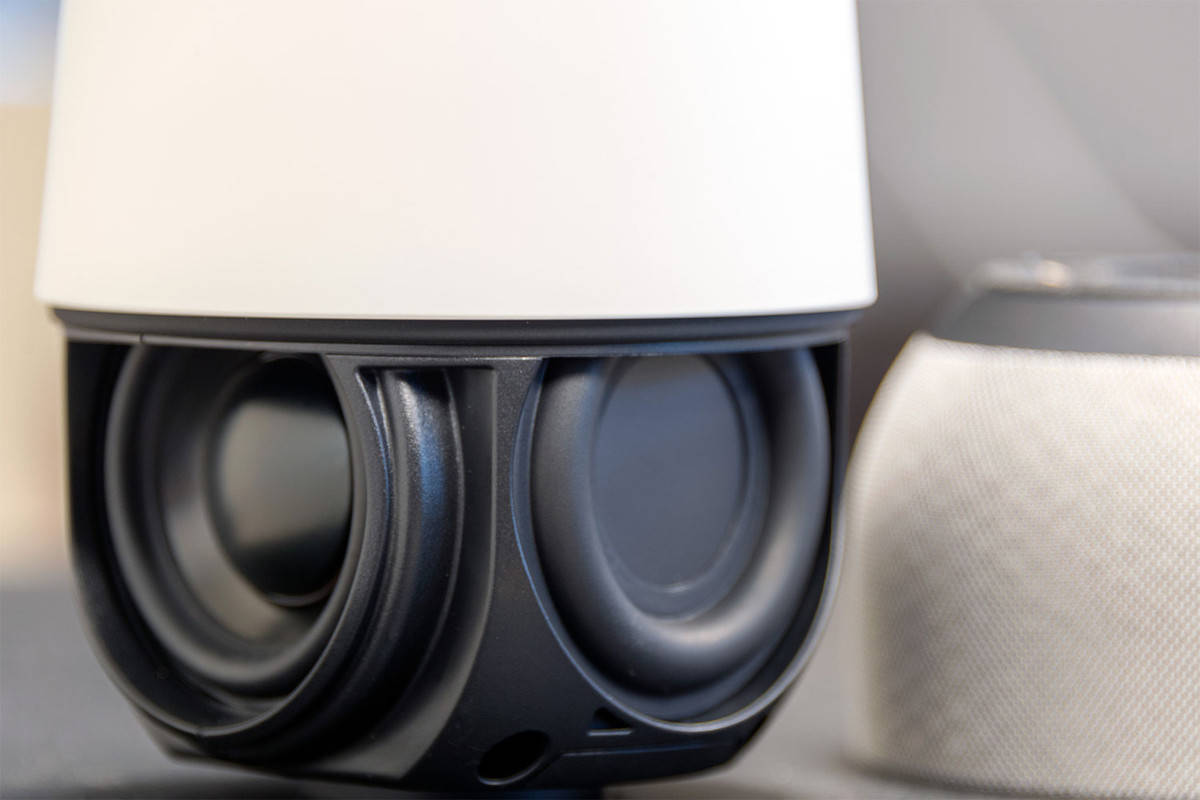I’ll admit it. I kept calling my Google Home “Alexa” (followed by an expletive when my Dot perked up, ready to help). But can you blame me? There’s a lot of overlap between Google’s voice-controlled speaker and Amazon’s range of devices with Alexa. Both have smart assistants that can tell you the latest news and weather, keep track of appointments, control your smart home, and — of course — play music.
The two aren’t exactly equal though. The Home is squatter, cheaper (by $50), and more customizable than the Echo, because you can swap out the bases to choose a cloth or metal one in a variety of colors. But the differences are more than skin deep. Here’s the good, bad, and uncanny when it comes to Google Home.
Design and features
The Home reminds me a little of a nesting doll that’s had its top shorn off at an angle. It’s white and comes with a gray base, but for another $20 you can get orange, purple, or teal fabric, and $40 will get you a metal version in black, white, or copper. (They actually have fancier names, but I’m not going to call something mango and expect you to know what I’m talking about.)
The angled top is touch-sensitive and illuminates with multi-colored dots when you summon the device with an “OK, Google” or “Hey, Google,” the phrases that signal it should start listening. You can use the surface to change the volume, start a request, play or pause music, or turn off an alarm or timer. There’s a microphone button in the back, so you can ensure the device isn’t listening.
Inside are two far-field microphones, five fewer than the Echo’s seven. I was fine calling out commands in my 850-square-foot condo, but that’s because the Home was centrally located. If you have more than one, only the nearest one should respond, so you don’t have a chorus of Homes answering your requests.
Getting Google Home up and running takes just minutes. I downloaded the iOS Google Home app, added the device, and was walked through a few basics on my phone. Then it was ready to start doing my bidding.
Tell me all your thoughts
It’s only natural to compare the Home and the Dot, which sits right next to it in my living room right now. The first thing I noticed is that saying “Hey, Google” feels less personal than asking Alexa for information or assistance. That being said, the Home knows its name. One of my colleagues tried to rouse it by calling it “Noodle” and got no answer. It also doesn’t listen when I call it Goober. I wish it did, though. I’d feel like it’s a little less formal.
You can ask the Home if you need a coat instead of asking for the weather, and it will respond appropriately.
The Home is quite good at figuring out exactly what I’m asking, even if I don’t phrase it a super-logical way. I did a head-to-head comparison between it and Alexa, and while the latter added a jacket to my shopping list when I asked if I needed a coat, the Home gave me a weather report. Google pulls from its knowledge graph to answer questions, and it often results in more detailed answers than Alexa gives. That said, sometimes the top answer is a bit out of date or incomplete. When I asked for the seven wonders of the world, for example, Google Home listed a couple and then said “and others.” That’s not all that helpful.
Google Home is also programmed to be personable, and the company hired writers from Pixar and The Onion to help. If you go down this list of Alexa Easter eggs, you can see quite a bit of overlap with fun, nerdy responses. If you want to know where in the world is Carmen Sandiego, the Home may reply, “I hear she sneaks around the world. Try Kiev or Carolina.” But when I said, “Hello, my name is Inigo Montoya,” Google Home asked, “You’d like me to call you Inigo Montoya. Is that right?” Not quite the response I was looking for, but now that I think about it, I’ll take it.
Keep tabs
The fact that Google Home initially called me “Caleb” when I said good morning is a result of one big drawback of the device: Right now, you can only have one account linked at a time. When I was testing it out, I had to do a factory reset on it (by holding down the microphone button for 15 seconds) to delete my colleague’s account, because he’d gotten his mitts on it first.
Due to the one-account capability, only my calendar events are listed when I ask the Home what’s going on today. It only pulls events from my “main” calendar, at the moment. When I asked what events I have this weekend, it said it couldn’t find any — yet, I have two things scheduled on the shared calendar I have with my husband. The Home will only give me details on my commute, as well. Alexa has the ability to switch between profiles, and that ability will likely show up on the Home as well.
I’m not quite sure what the use (or potential creep factor) of this is yet, but when I asked for the Home’s favorite animal (puppies), it asked for mine in return. Later, when asked it if it knew my favorite animal, it replied, “You told me that you like kitties.”
In control
Alexa launched with limited ability to control smart-home devices, and Google Home works with a similar small number at the moment: Philips Hue bulbs, SmartThings devices, Nest, and If This Then That recipes. What it does, it does well, though. While I need a complicated recipe from a third-party app to turn my Hue bulbs purple with Alexa, Google Home does it all on its own.
Home goes beyond just bulbs and thermostats, though, working with your Chromecast to stream content to your TV. That could be pretty powerful in the future for the screenless device — like if you wanted to know what a marmoset looks like, for example.
Crank it up
Google Home supports Google Play Music, YouTube Music, Spotify, and Pandora. You can select a default player to handle all your music-related requests, so that you don’t have to specify an app each time. I linked my Spotify playlist and asked Google Home to play my ‘Ello, Charlie” playlist, which is the one I made for my sister when she was giving birth. I specifically chose it, because Alexa has trouble playing that one (I suspect the apostrophe is the culprit), but the Home had no trouble firing it up.
When it comes to podcasts, it’s hard to know exactly what’s supported, as there’s no list, and you can’t select your lists from Spotify or TuneIn at the moment. You also can’t request the Home play a specific episode, but you can say, “Play the My Favorite Murder podcast,” then ask it to play the previous episode.
To evaluate sound quality, DT’s Senior Editor Caleb Denison gave it a listen. It sounds closer to the Amazon Echo Tap than the full-size Echo speaker, which is admittedly a bit larger than the Home. While Amazon’s full-size Echo has a very large sound with full bass that doesn’t go overboard, Google’s Home over-juices the bass, and ends up sounding like it’s trying too hard. The Echo and Echo Tap can each get a bit louder before moving into distortion territory than the Home can, too – we found the Google Home would start sounding compressed and a little dirty when we pushed the volume too hard.
More: Here’s what happened when we asked Amazon’s Alexa and Google Home a bunch of questions
As a speaker, the Home may not be able to top the Echo or Echo Tap, but considering its intended use, we think most folks will find it sounds just fine. Don’t get too excited about the notion of 360-degree audio, though. While the Home does use passive drivers to emit sound in multiple directions, it has hot and cold spots. Still, especially if placed near a corner, the Home can deliver a room-filling punch.
What can’t it do?
Right now, the Home’s biggest limitation is its smart-home compatibility and “skills.” You can use it to call an Uber, but that’s about it in terms of third-party support. Alexa has over 3,000 skills, but it’s been around for almost two years. Plus, some of these skills are pretty gimmicky, and you do have to enable them to use them. I’ve also found some to be buggy, like the Food Network app. It’s supposed to send you recipes from the show that’s currently on, but I’ve never gotten this to work. Eventually, the Home will likely add more third-party abilities, expanding its usefulness.
Right now, you can only have one account linked at a time.
Google Home isn’t always on the nose when it comes to answering questions. I asked, “How many VMAs does Beyoncé have?” and it told me she won for Video of the Year. For the record, she has 24. And while the Home thinks she has 18 Grammy Awards, Grammy.com says the singer has 20. (In case you’re wondering, Alexa didn’t even venture a guess on either question.)
I also had a few problems with some of the assistant-y stuff. When I asked what I should have for lunch, the speaker offered several restaurants based on my location. It doesn’t have my address exactly right, but close enough. One restaurant it suggested didn’t open until 5 p.m. When I asked for its hours, Home confirmed that it wasn’t open yet. If it were a little smarter, it wouldn’t have suggested that particular restaurant in the first place.
Our Take
With its knowledge-graph-backed smarts, the Google Home often gives you just the answer you’re looking for. Alexa crawled before she walked, too, so the Home could very well be keeping pace with Amazon’s assistant in a year.
Is there a better alternative?
In case you can’t tell, the $129 Google Home’s biggest competition is the range of Alexa products from Amazon, including the $180 Echo and the $50 Dot. Right now, Alexa wins out in terms of capabilities — like smart home control and skills — but Google Home is better at answering questions and their follow-ups. There are some updates we’re looking forward to for the Home, like the ability to use multiple profiles, too.
The DT Accessory Pack
How long will it last?
In the immediate future, Google Home should only get better with new software updates and more third-party integration. But we can’t promise the company won’t eventually roll out a newer version with, say, more microphones and the ability to release a burst of scent to go along with its air freshener-esque appearance.
Should you buy it?
If you have a Chromecast, the Google Home is the clear choice over an Alexa device, but if you’re looking for a voice-controlled speaker with a smart assistant, they’re both pretty good options, and it comes down to personal preference. At the moment, Alexa wins on personality and skills, but the Home has the upper hand when it comes to knowing your routine and understanding you and your questions.

